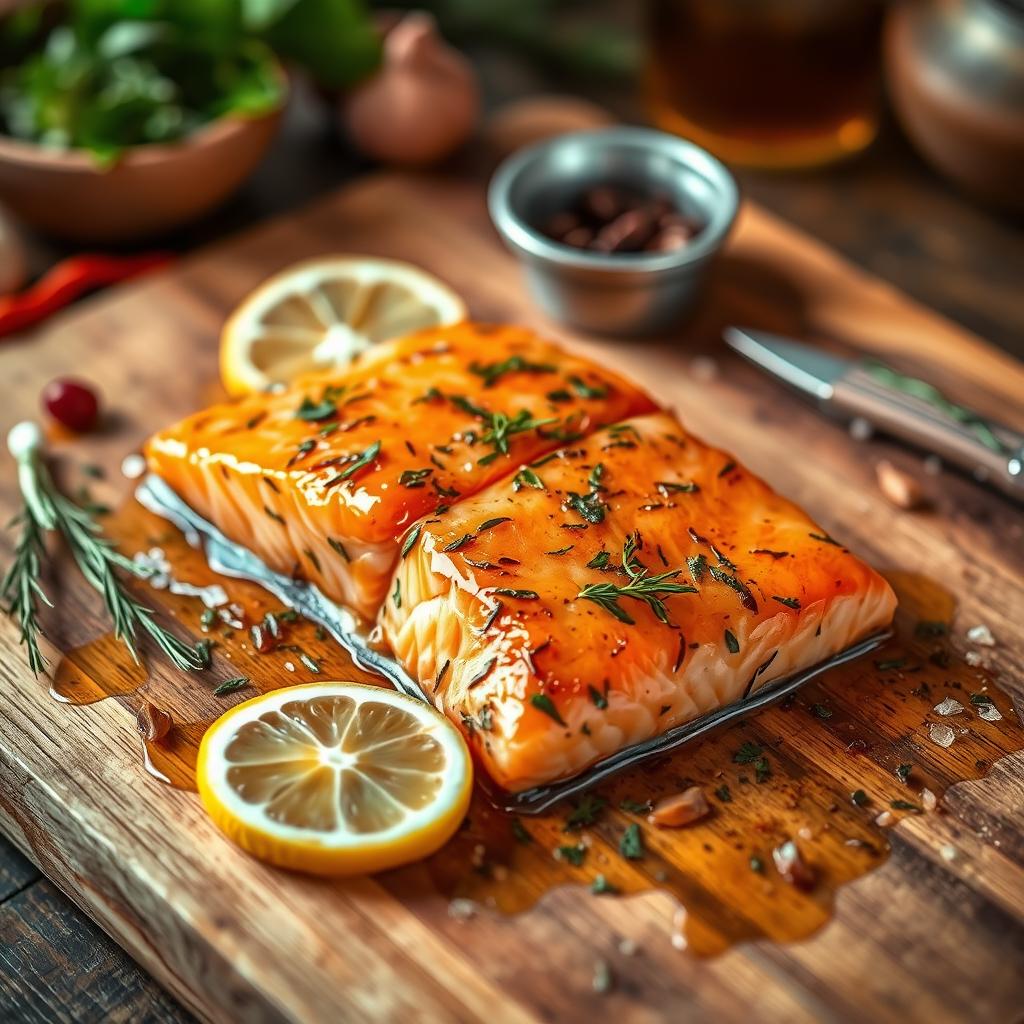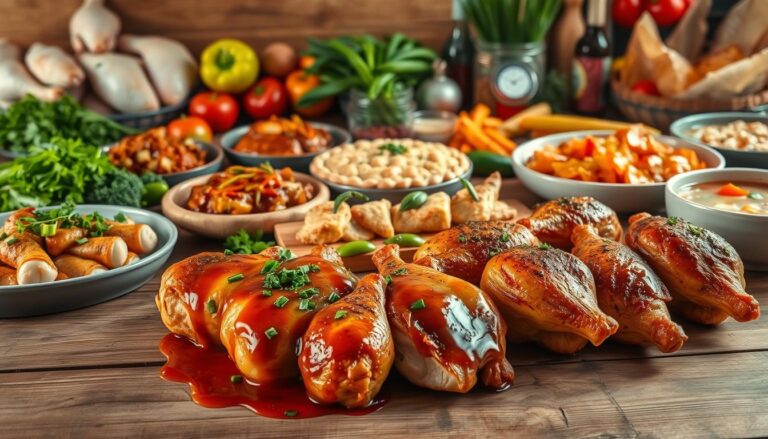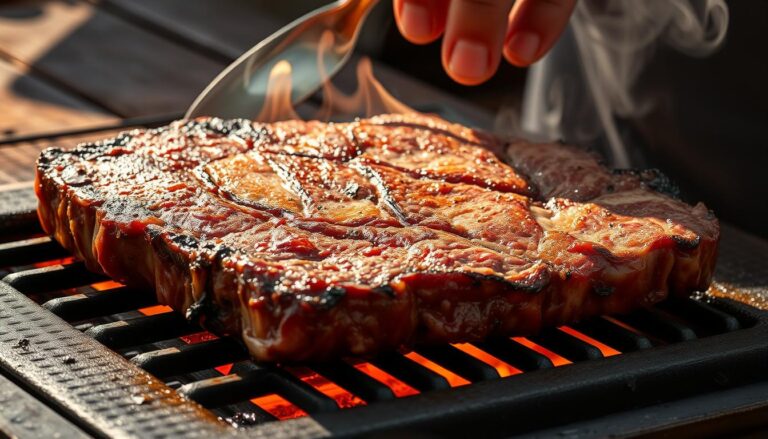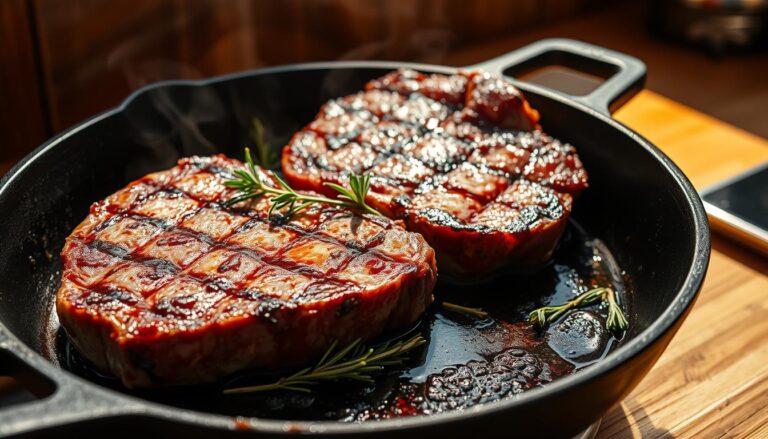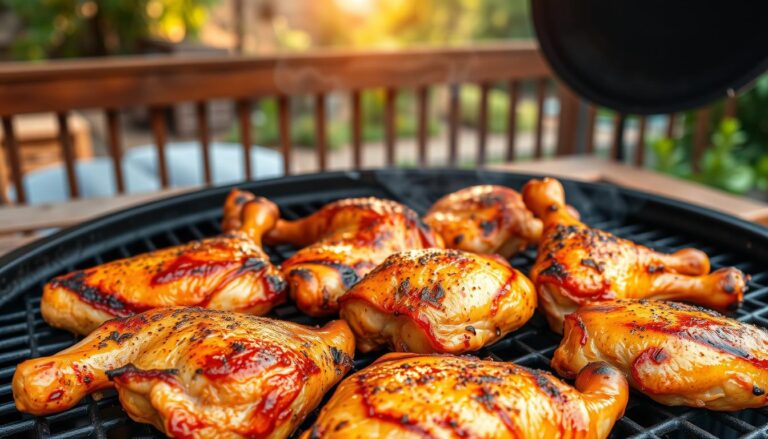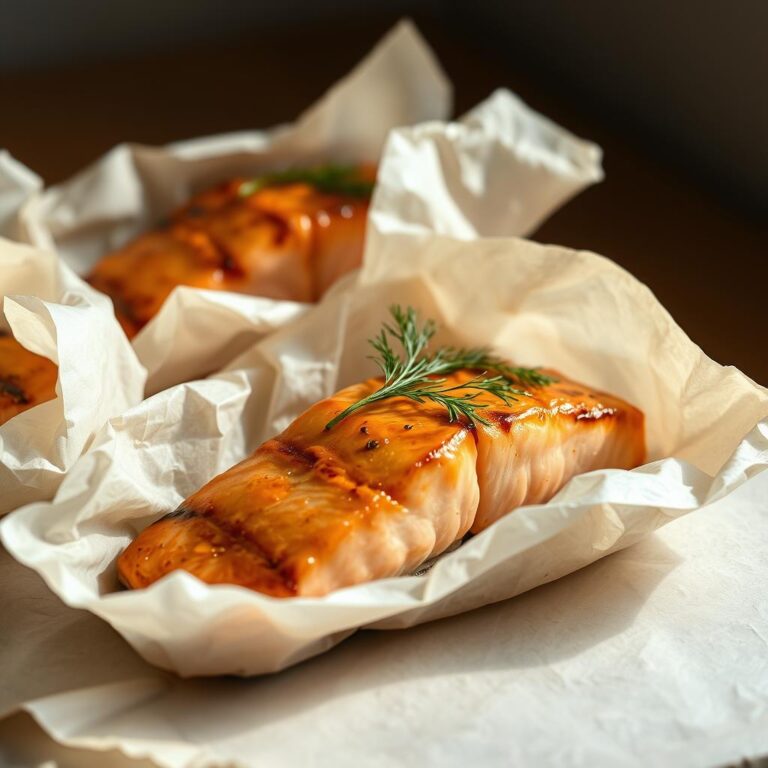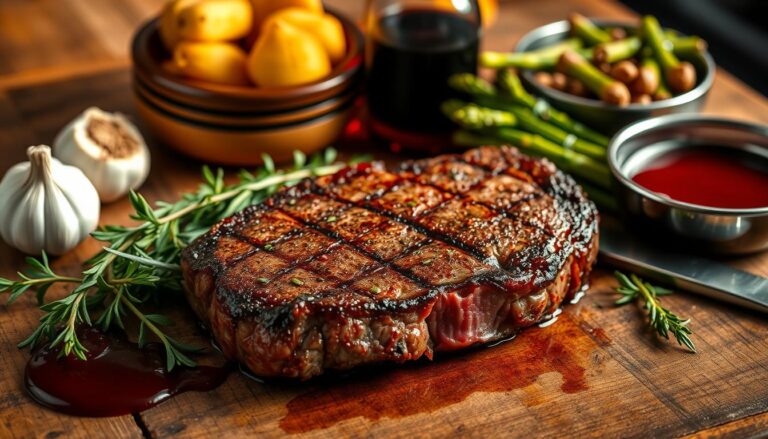How to Make Homemade Marinated Salmon: A Complete Marinated Salmon Recipe Guide
Every great culinary journey starts with a single, perfectly prepared dish. For me, mastering homemade marinated salmon was a game-changer. The first time I made a restaurant-quality marinade, I saw cooking as more than just following a recipe. It’s about creating an experience that excites the senses.
Creating the perfect salmon marinade recipe is a journey that mixes science and creativity. Whether you’re a home cook wanting to impress your family or a food enthusiast looking to improve your skills, this guide is here for you.
In this detailed guide, you’ll learn how to turn an ordinary salmon fillet into an extraordinary meal. We’ll cover everything from choosing the freshest ingredients to trying new marinade techniques. You’ll discover how to make homemade marinated salmon that will delight your taste buds.
Key Takeaways
- Learn professional techniques for marinating salmon
- Discover multiple flavor profiles and marinade styles
- Understand the importance of ingredient selection
- Master cooking methods for perfectly prepared salmon
- Explore health benefits of marinaded salmon dishes
Benefits of Marinated Salmon for Your Health
Salmon is not just tasty; it’s also packed with nutrients. Choosing marinated salmon is good for your taste buds and your health. It gives your body essential nutrients.
Salmon is a top pick for those who care about nutrition. It offers many health benefits. Let’s look at how salmon can improve your well-being.
Rich Source of Omega-3 Fatty Acids
Omega-3 fatty acids are super important, and salmon has lots of them. These fats are great for your heart and brain. Your body can’t make them, so salmon is a key food source.
- Supports cardiovascular health
- Reduces inflammation
- Enhances cognitive function
- Promotes brain cell regeneration
High-Quality Protein Content
Salmon’s protein is top-notch. It’s full of complete protein, which is vital for muscles and body repair.
| Protein Benefit | Impact on Body |
|---|---|
| Muscle Repair | Supports post-workout recovery |
| Metabolism Boost | Increases calorie burning |
| Satiety | Helps control hunger |
Essential Vitamins and Minerals
Salmon has more than just omega-3s and protein. It’s also full of important vitamins and minerals. Vitamin D, B12, selenium, and potassium are some of the key nutrients it offers.
- Vitamin D for bone health
- B12 for energy production
- Selenium for immune function
- Potassium for heart regulation
Eating marinated salmon is more than just enjoying a meal. It’s a smart choice for your health and well-being.
Essential Ingredients for Perfect Salmon Marinade
To make the best marinade for salmon, you need to know the key ingredients. These ingredients turn a simple fish into a dish that wows everyone. The right mix of ingredients can take your dish from good to great.
Your marinade should have three main parts: acids, oils, and seasonings. Each one is important for flavor and texture.
- Acids: Lemon juice, vinegar, or wine tenderize the salmon and add a bright taste
- Oils: Olive oil or neutral oils make a smooth base and help herbs stick
- Seasonings: Fresh herbs, garlic, and spices add depth and complexity
Professional chefs say to use high-quality, fresh ingredients for the best marinade. You want to enhance the fish’s flavor, not hide it.
Now, let’s look at some top ingredients for a delicious salmon marinade:
- Fresh lemon juice
- Extra virgin olive oil
- Minced garlic
- Fresh dill or parsley
- Dijon mustard
- Salt and black pepper
Each ingredient adds something special to your marinade. Acids break down proteins, oils keep it moist, and seasonings make it taste amazing. This makes your salmon unforgettable.
How to Make Homemade Marinated Salmon
Learning to marinate salmon can turn a simple dish into a gourmet delight. It’s all about the details and knowing the right steps. These steps will make your seafood taste better and feel more tender.
Preparing the Salmon Fillets
Begin with fresh, top-quality salmon fillets. Here’s what to do:
- Rinse salmon under cold water
- Pat dry with paper towels
- Remove any visible pin bones
- Trim excess skin if desired
Creating the Marinade Base
The marinade’s taste is key. A good marinade has:
- An acid like citrus juice or vinegar
- Oil for moisture
- Herbs and spices for flavor
- Salt and pepper to boost taste
Marination Time and Temperature
Marinating salmon right is important. Refrigerate your salmon while marinating to avoid bacterial growth. Here’s what works best:
- Thin fillets: 30 minutes to 1 hour
- Thicker cuts: 1-2 hours maximum
- Always marinate in a covered, non-reactive container
- Keep temperature between 35-40°F
By mastering these salmon marination techniques, you’ll make a dish that’s both delicious and impressive.
Basic Lemon and Garlic Marinade Recipe
Making a great lemon garlic salmon marinade is simple. This easy recipe will turn your fish into a dish fit for a restaurant.
The secret to a top-notch marinade is mixing bright citrus with strong garlic. Start by picking fresh ingredients that match the salmon’s rich taste.
Essential Ingredients
- 1/4 cup fresh lemon juice
- 3 cloves minced garlic
- 1/3 cup olive oil
- 1 teaspoon dried oregano
- 1 teaspoon fresh thyme
- Salt and pepper to taste
These ingredients make a powerful marinade that adds amazing flavor to your salmon. The lemon’s acid tenderizes the fish and breaks down proteins.
Marinade Preparation Steps
- Whisk all ingredients together in a bowl
- Place salmon fillets in a shallow dish
- Pour marinade over salmon
- Cover and refrigerate for 30 minutes
Pro tip: Don’t marinate salmon for more than 30-45 minutes. Acid can “cook” the fish and alter its texture.
Flavor Intensity Guide
| Garlic Amount | Flavor Intensity | Recommended Use |
|---|---|---|
| 1-2 cloves | Mild | Subtle flavor |
| 3-4 cloves | Medium | Balanced taste |
| 5-6 cloves | Strong | Robust garlic lovers |
Your lemon garlic salmon marinade is now ready to make your next seafood meal unforgettable!
Herb and Citrus Marinade Variations
Take your salmon dishes to the next level with exciting marinades. These marinades can turn a simple fish into a culinary masterpiece. Exploring different marinades can unlock amazing flavors that will delight your taste buds and impress your guests.
Discovering unique marinades lets you experiment with global flavors. This turns an ordinary meal into an extraordinary dining experience. Let’s look at three distinctive marinade styles that will change how you prepare salmon.
Mediterranean Salmon Marinade
The Mediterranean salmon marinade brings coastal flavors to your kitchen. It focuses on fresh herbs and bright citrus notes that perfectly complement the salmon.
- Rosemary and thyme for aromatic depth
- Fresh lemon juice for brightness
- Extra virgin olive oil
- Crushed garlic cloves
Asian-Inspired Salmon Marinade
An Asian salmon marinade introduces complex umami flavors. These marinades blend salty, sweet, and tangy elements, turning your fish into a sophisticated dish.
- Soy sauce for saltiness
- Ginger for warmth
- Sesame oil for richness
- Honey for subtle sweetness
Spicy Marinade Options
For those who enjoy a kick, spicy marinades add excitement. These marinades use ingredients that add heat and wake up your palate.
| Spice Level | Key Ingredients | Flavor Profile |
|---|---|---|
| Mild | Paprika, black pepper | Gentle warmth |
| Medium | Sriracha, chili flakes | Noticeable heat |
| Hot | Cayenne, habanero | Intense spiciness |
Remember, marinating times should be the same for all variations. Aim for 30 minutes to 2 hours for the best flavor without harming the salmon’s texture.
Best Cooking Methods for Marinated Salmon
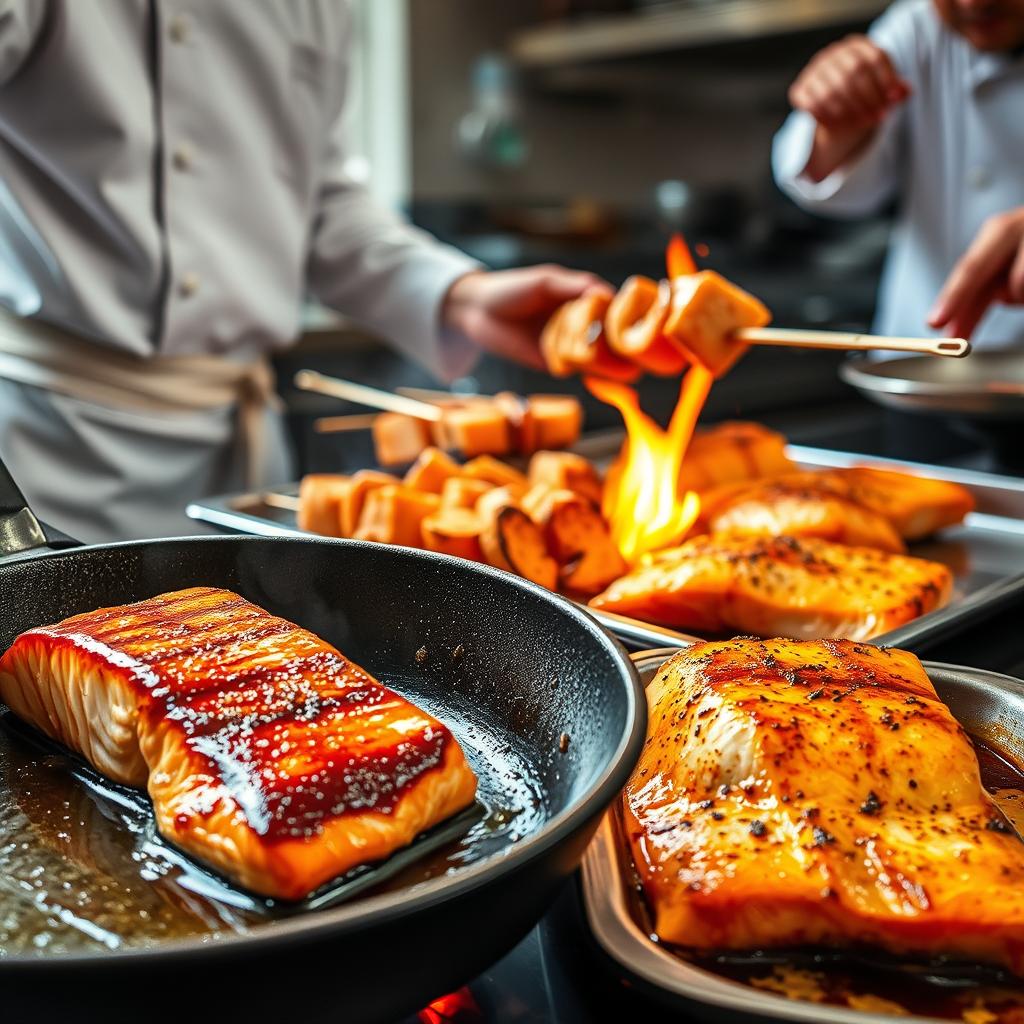
Learning how to cook marinated salmon is key. It’s about finding the right cooking techniques to enhance flavors and textures. Each method has its own benefits for your seafood dish.
When looking for the best way to cook salmon, consider these main methods:
- Oven-Baking: A reliable method that ensures even cooking and keeps moisture in
- Grilling: Adds smoky flavor and creates beautiful grill marks
- Pan-Searing: Creates a crispy exterior while keeping the inside tender
- Broiling: Produces a caramelized top and quick cooking time
Oven-baking is the most consistent method for marinated salmon. Preheat your oven to 400°F and bake for about 12-15 minutes, depending on the fillet’s thickness. This method is great for most marinades, keeping the fish’s delicate texture.
Grilling is a fantastic choice for a smoky flavor. Make sure your grill is preheated to medium-high heat. Use a clean, well-oiled grate to prevent sticking. Cook for 4-5 minutes per side, letting the marinade caramelize slightly.
For those who like versatility, pan-searing is a great option. Heat a skillet with a bit of oil, then cook your marinated salmon for 3-4 minutes on each side. This method is perfect for Asian-inspired and citrus marinades.
Temperature Guidelines and Cooking Times
Cooking salmon to the right temperature makes it delicious and safe. Knowing the salmon cooking temperature and how long to cook it can make your seafood dishes amazing.
Different cooking methods need specific temperature ranges for the best results. Your goal is to cook salmon until it reaches an internal temperature of 145°F (63°C). This ensures both safety and flavor.
Oven-Baked Salmon Cooking Instructions
When baking salmon in the oven, follow these key guidelines:
- Preheat oven to 425°F (218°C)
- Place salmon skin-side down on a baking sheet
- Cook for 12-15 minutes depending on fillet thickness
- Check internal temperature with a meat thermometer
Grilling Temperature Recommendations
Grilling salmon needs precise heat control to prevent drying out the fish.
| Salmon Type | Grill Temperature | Cooking Time |
|---|---|---|
| Whole Salmon | 375-400°F | 10-12 minutes per side |
| Salmon Fillets | 400-450°F | 4-6 minutes per side |
| Salmon Steaks | 350-375°F | 5-7 minutes per side |
Pro tip: Always let your salmon rest for 3-5 minutes after cooking. This allows juices to redistribute, making it moist and flavorful.
Tips for Selecting Fresh Salmon
Choosing the right salmon is key for tasty marinated dishes. To pick the best salmon, focus on a few important factors. These will help you find the freshest and tastiest fish for your recipe.
Start by looking at the salmon’s color. It should be bright orange-red to deep pink. If it’s dull or discolored, it’s not fresh.
- Check for firm, glossy flesh without any brown or dried-out edges
- Ensure the fish has a clean, ocean-like smell
- Avoid salmon with a strong fishy odor
- Look for consistent color without gray or white patches
Different salmon types have unique flavors. Wild-caught salmon tastes richer, while farm-raised salmon is milder and more consistent.
| Salmon Type | Flavor Profile | Best Use |
|---|---|---|
| Sockeye | Rich, intense | Grilling, strong marinades |
| King (Chinook) | Buttery, smooth | Delicate marinades |
| Coho | Mild, moderate | Versatile marinades |
Buy salmon from trusted fishmongers or seafood counters. Fresh salmon should be cold and slightly firm. Store it in the fridge or freezer right away to keep it fresh.
Common Marination Mistakes to Avoid
Mastering salmon marination needs precision and care. Knowing common mistakes can make your cooking better. Even skilled home chefs can make errors that ruin salmon’s texture and taste.
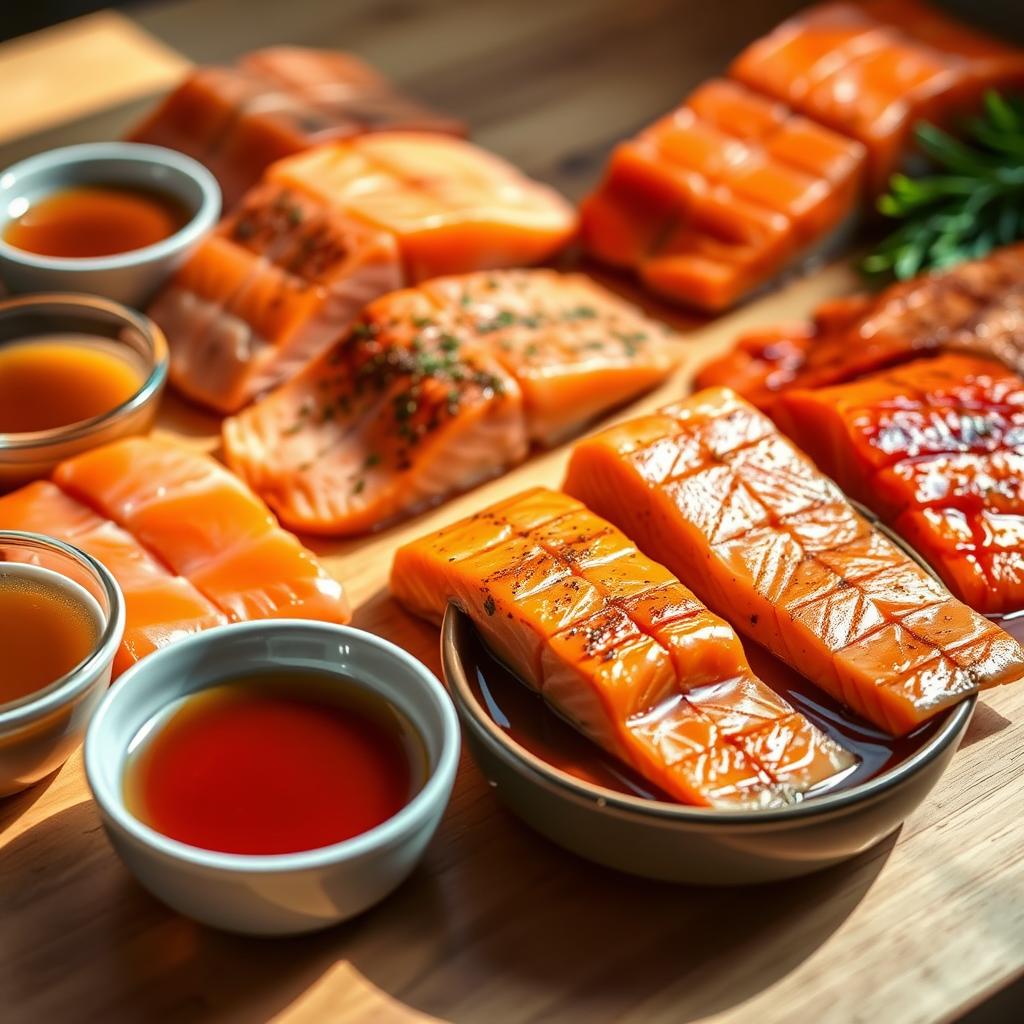
When making marinated salmon, several mistakes can ruin your dish. Learning to avoid over-marinating and using the right techniques will improve your seafood cooking.
Dangers of Over-Marinating
One big mistake is marinating fish too long. The acids in marinades can “cook” the salmon, making it mushy. Here’s how to avoid this:
- Limit marination time to 30 minutes for delicate fish
- Use less acidic ingredients for longer marination periods
- Refrigerate during marination to control chemical reactions
Improper Storage Techniques
Proper storage is key when marinating salmon. Always use non-reactive containers like glass or ceramic. Metal containers can react with marinades and change the fish’s taste.
Marinade Ratio Challenges
Finding the right marinade ratio is important. Too much acid can break down salmon’s proteins, while too little seasoning makes it taste bland. Start with:
- 3 parts oil
- 1 part acid (citrus or vinegar)
- Seasonings to taste
By avoiding these common mistakes, you’ll make perfectly seasoned, tender salmon every time.
Serving Suggestions and Side Dishes
Choosing the right side dishes for salmon can make your meal amazing. You want to balance your plate with flavors that match your fish.
Light and fresh sides are best with salmon’s soft texture. Here are some great options:
- Roasted vegetable medley with asparagus and bell peppers
- Quinoa salad with fresh herbs
- Garlic-roasted new potatoes
- Citrus-infused wild rice
Your side dishes should be both healthy and look good. Colorful vegetables make your plate pop and add nutrients.
Think about texture and flavor when picking sides for salmon. Creamy risottos, crisp salads, and grain sides can make your dish better. Roasted seasonal veggies with olive oil and herbs are a great choice too.
- Mediterranean-style couscous
- Grilled zucchini with lemon zest
- Honey-glazed carrots
- Spinach and arugula salad
Don’t forget about how your meal looks. Arrange your salmon and sides to make a dish that looks as good as it tastes.
Storage and Leftover Guidelines
Learning how to store cooked salmon is key to keeping flavors fresh and preventing waste. It’s important to store your salmon right to keep it tasty and safe to eat.
Here are some important tips for storing leftover salmon:
- Refrigerate cooked salmon within two hours of cooking
- Store in an airtight container
- Keep refrigerated salmon for up to 3-4 days
- Always use shallow containers for even cooling
Freezing is a great way to keep salmon fresh longer. Wrap individual portions tightly in plastic wrap or aluminum foil before placing in freezer bags. This way, frozen salmon can stay good for up to 3 months.
When reheating leftover salmon, use gentle methods to avoid drying it out:
- Preheat oven to 275°F
- Place salmon in a baking dish
- Add a splash of water or lemon juice
- Cover with foil
- Warm for 10-15 minutes
Getting creative with leftover salmon can turn it into new, exciting dishes. Try making salmon salads, pasta dishes, or salmon cakes. This way, you can make the most of your leftovers and cut down on waste.
Conclusion
Making a tasty homemade marinated salmon recipe is more than cooking. It’s an art that blends nutrition, flavor, and creativity. By learning salmon marinade tips, you can turn a simple fish into a gourmet dish. This dish will please your taste buds and be good for your health.
Marinated salmon is very versatile. You can try many flavors, from Mediterranean herbs to Asian seasonings. Each marinade adds something special to your dish, making every meal a new adventure. Your skills in picking fresh salmon, marinating, and cooking will make your home cooking better.
Remember, trying new things is important to find your own salmon recipe. Don’t hesitate to mix ingredients, change marination times, and try different cooking methods. With time, you’ll find the perfect flavors that you love and that will wow your loved ones.
Your adventure with homemade marinated salmon is just starting. Be open to new experiences, trust your cooking skills, and enjoy making healthy, tasty meals. Show off your new cooking talents.

